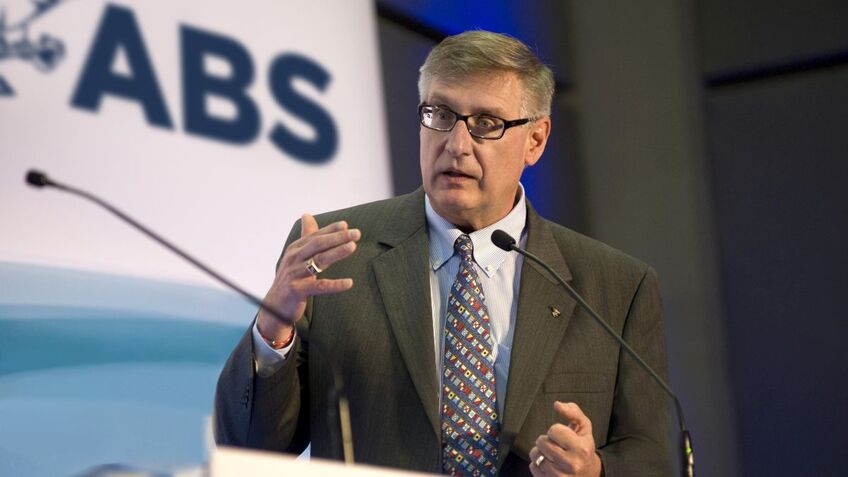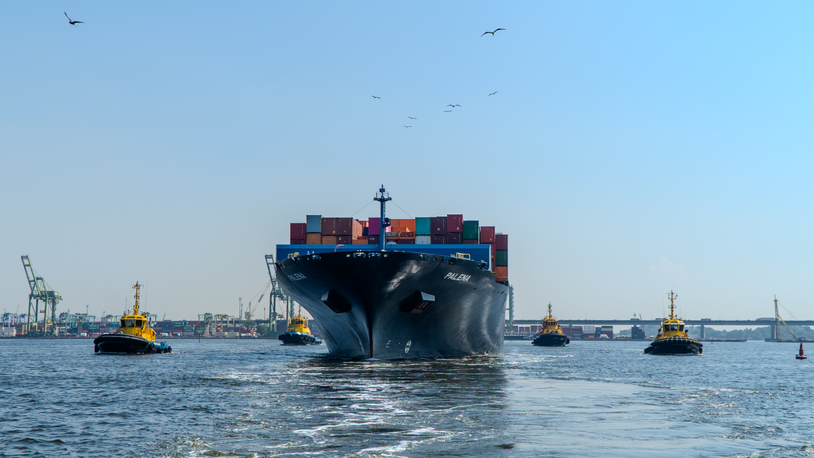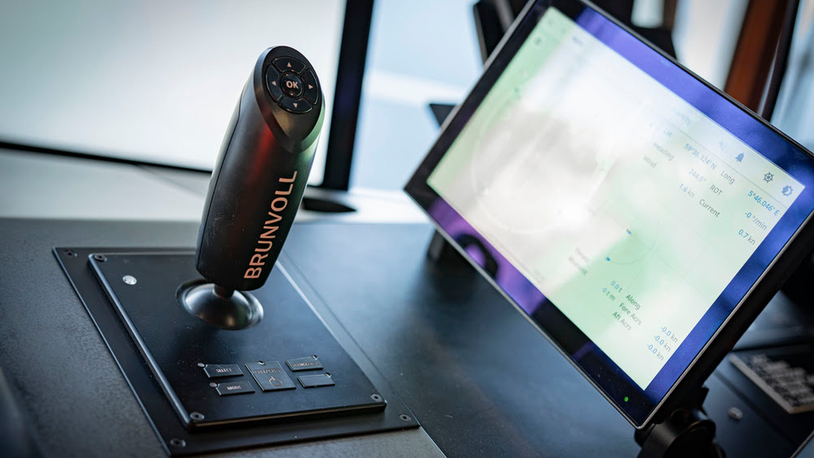Business Sectors
Events
Contents
Volvo Penta expands IPS programme
Improved propulsion efficiency for craft with speeds over 30 knots was the aim of Volvo Penta’s Inboard Performance System (IPS), and this year the company is launching a further two larger power classes
Since being introduced to the recreational market, more than 10,000 IPS units have been sold to 122 boatbuilders but the larger IPS3 drive on the new IPS 1200 and IPS 1050 types makes the product a viable option for commercial applications. Several IPS models, including the new IPS 1050, are now offered with an R4, light commercial rating, opening up a whole new spectrum of applications for the patrol boat and workboat market. The original R5 rating, designed specifically for the leisure market, can be used for some limited fast patrol boat applications.
During development of the IPS, several possibilities were investigated, including a fixed pod with a rudder, a fixed pod with a steerable nozzle and a transom mounted drive with pulling propellers. The ideal position for the propellers is ahead of the transom, under the boat, running in undisturbed water. For this reason, Volvo Penta decided on pulling and dual contra rotating propellers to maximise efficiency and to give the greatest blade area for the minimum propeller diameter. This would also reduce a boat’s draught.
IPS is not available as a single unit and is usually fitted in pairs, although triple and quad installations are also possible, according to power requirements. There is no tie rod connecting them and the units can move independently, controlled by a fly-by-wire computerised navigation system.
Since the units can move separately, a craft can, by creating a thrust vector, move in any direction, and the whole craft can rotate on its axis without the need for bow or stern thrusters. It is controlled at slow speed using a joy stick. The drives are angled while the gear shift and throttle setting are determined by computer.
Of the many advantages that the IPS drive has over conventional inboards with a P bracket, the most significant is the huge increase in efficiency – according to Volvo Penta, this is as great as 35 per cent. This manifests itself in a higher top speed or greater fuel economy.
In practice, a value of over 35 per cent may be achievable in optimum conditions, while for a workboat in commercial applications a fuel saving of 15-20 per cent should be attainable. Given the high number of annual running hours in commercial or military applications, the fuel saving in money terms will be substantial. The higher top speed and greatly improved handling are additional benefits that will be appreciated by the crew but are difficult to quantify in financial terms.
Several boatyards have been quick to grasp the significance of the IPS drive and already they are being offered as standard equipment on seven workboats. Compared to inboards, there is a considerable space saving, giving more room inside the hull. For example, in a 13m (40ft) hull one more cabin can be incorporated.
IPS can be positioned in the stern with the engine connected directly to the propulsion units with a short shaft in the so called compact arrangement, or the engine can be positioned as far forward as required using a longer jackshaft. A midships engine location would allow for a very low cockpit deck aft according to the vessel design.
For a boatbuilder, the ease and speed of installation is a considerable saving, and alignment problems are eliminated by the computerised steering/navigation arrangement. Typical installation times can be more than halved; for example, a twin IPS can be installed in eight hours whereas a twin inboard installation of a similar power could easily take 40 hours.
After the drive unit is installed, the engine is bolted to its mounts. Two universal couplings on the drive shaft compensate for any misalignment.
Greater hull integrity is assured since only one aperture for each IPS drive is required; the cooling water, drive shaft and exhaust all pass through this. After installation, a setup programme is initiated and the drives synchronise themselves. The steering, throttle and instrumentation is completed by plugging the various parts to the wiring harness of the supplied electronic vessel control (EVC) system, forming a digital CAN bus network. No cable adjustments are required, regardless of whether a single or dual command station is used.
References for the IPS include Damen Shipyards, the Netherlands, which is offering the IPS400MC on its 10.7m Stan Patrol Boat powered by D6 engines, giving a maximum speed up to 36 knots. South Boats Special Projects in the UK currently has three boats on offer powered by the IPS, and Baltic Workboats AS in Estonia has a 16m fast pilot boat in its programme powered by twin IPS 1050’s, giving a top speed around 37 knots. A larger 24m fast patrol boat is powered by triple IPS 1050 units, giving a top speed of 32 knots.
The present IPS programme covers 11 models using three sizes of drives: IP1, IP2 and IP3. The engines powering the drives range from the Volvo Penta D4 of 191kW at 3,500 rpm, through the D11 of 441kW at 2,300 rpm, up to the largest D13 of 662kW at 2,300rpm. At present, the IPS 400MC, 450, 800 and 1050 models have full light commercial (R4) ratings: all the other models are R5 recreational rated. In selected markets two V8 petrol powered IPS 500G and IPS550G models are available, with the latter offering a catalytic converter.
The drive units use contra-rotating pulling propellers; the torpedo of the gear housing is used to combine exhaust with cooling water and bury the exhaust deep in the trailing propeller stream. Forward facing propellers provide ‘clean’ water undisturbed by any slipstream, so as to maximise efficiency.
Handling is improved at both high and low speed as the whole thruster unit underwater swivels to vector full thrust in the desired direction. Considerably tighter turning circles can be achieved with IPS – a much appreciated attribute when chasing or intercepting evading outboard powered craft, as used by smugglers and pirates. The contra rotating propellers give neutral tracking, eliminating the paddle wheel effect that normally makes manoeuvring difficult at slow speed.
The horizontal thrust of the units is parallel to the boat’s bottom, giving an immediate advantage over less efficient shaft drive inboards that require a P bracket. There is no rotating propeller shaft in the water to attract drag and reduce efficiency. Because an inboard shaft lies at an angle and not running parallel to the boat’s bottom, further losses are incurred compared to an IPS.
In a comparison test arranged by Volvo Penta on two identical 12.4m craft, one with an IPS and electronically controlled diesel engine, the other with a Volvo Penta conventional inboard drive and mechanical injection diesel engine of the same power, the IPS demonstrated a 20 per cent speed advantage, reaching 37 knots. The inboard attained only 31 knots; to match the IPS performance it is necessary to add 110kW for each engine. Throttling back to run the IPS boat at 31 knots provides a major saving in fuel consumption and consequently a substantial increase in operating radius.
Sound and vibration levels, and exhaust emissions are important concerns of any boat operator and contribute to the comfort of the crew. In the above 12.4m craft comparison, the difference in sound level measured was up to 7 dB(A), with the IPS installation demonstrably quieter.
The noise attenuation is due to the IPS being mounted to the hull using a rubber doughnut, which reduces conducted noise and vibration compared to a standard inboard arrangement with P bracket, bolted straight to the hull. There is also the robust engine and gearbox mounting absorbing propeller thrust.
In the IPS, thrust is carried by the drive and rubber mounting, leaving the engine mountings to be relatively soft and therefore better able to absorb engine noise and vibration. Exhaust gas is discharged through the propulsion unit into the centre of the propeller wash and is hence carried away astern.
The IPS, being a multiple installation with a minimum of two drives, gives the inherent safety of redundancy. One drive can propel and steer the boat with ease, and in the unfortunate case of striking an underwater object at speed, the drive is designed to shear off at pre determined break points, leaving hull integrity unaffected.
As part of a fly-by-wire electronic system, IPS cannot function properly without a computer controlling it. The EVC includes everything from the helm to the drive. It is a CAN bus system that integrates with an autopilot and other NMEA 2000 compatible instruments and accessories. A recent addition is an optional dynamic positioning capability, which maintains the boat’s position and attitude automatically from GPS signals. Inbuilt redundancy features two parallel systems. MP
Related to this Story
Events
Maritime Environmental Protection Webinar Week
Cyber & Vessel Security Webinar Week
The illusion of safety: what we're getting wrong about crews, tech, and fatigue
Responsible Ship Recycling Forum 2025
© 2024 Riviera Maritime Media Ltd.













